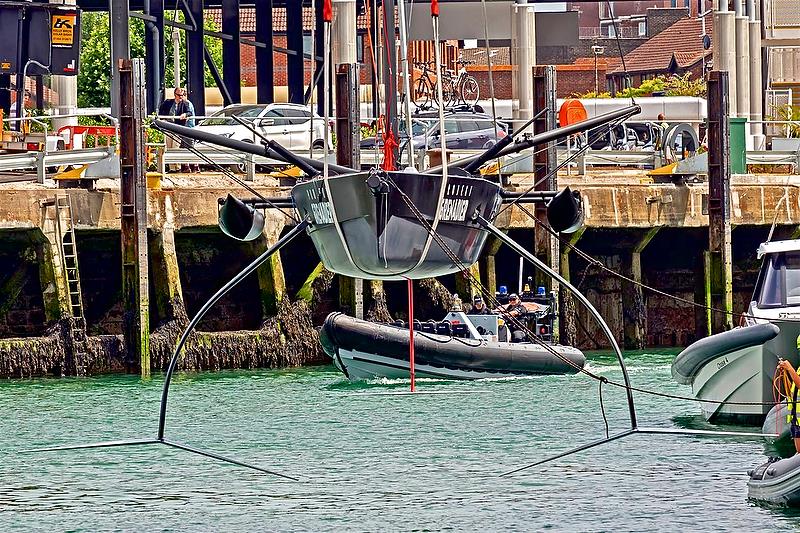
America's Cup: First video of INEOS Team UK's foiling monohull
by Richard Gladwell, Sail-World.com/nz 25 Jul 2018 01:28 UTC
25 July 2018

INEOS Team UK launch the modified QUANT 28 in Portsmouth © Paul Skirrow
First video of the modified QUANT 28 fitted with AC75 type foiling system, test sailing on the Solent.
Video from the London Corinthian Sailing Club by Harry Aitchison
Sources in UK have it that the prototype is sailing downwind at speeds of 30kts in 12 kts of wind, and upwind at 20kts - and is performing foiling tacks and gybes with relative ease.
From the top of site image, the wings and arms look disproportionate in size for a 28ft boat (8.65mtr). The maximum length allowed for surrogate or test boat is 12.0mtr (39ft 4") - and the INEOS Team UK test boat is more than 10ft under the maximum length.
The wing length on an AC75 is 2.0mtr from the centre of the arm, or overall span of 4.0mtr. Crude scaling would tend to the view that the 28fter has been fitted with wings and arms suitable for a near full size Surrogate/Test boat. Similarly for the mast support struts which give a rig support base similar to that expected on the development boat - explaining why these are fitted when they are not part of the AC75.
How all this scales up into an AC75 remains to be seen, but for the doubters there would seem to be little doubt that the foiling monohull concept works, the speeds impressive and should more than match the claims that the AC75 will be faster than the AC50.
Key take-outs from the short video are that the flight is relatively constant - not dissimilar to Emirates Team NZ's AC50, which was the pick of the fleet in that regard in Bermuda.
Video of INEOS Team UK gybing
It is not known if the flight height is being controlled by a computer system or if it is manually controlled. Given that there are just two crew onboard the 28fter compared to the 11 crew allowed on the AC75, one tends to the view that the 28ter has fully automated foiling systems.
The AC75 has adjustable flaps on the back edge of the wing, rather than controlling ride height by moving the whole daggerboard as was the case in the AC50. From the video it would seem that this aspect of the prototype and AC75 is working as intended.
With crude scaling on the video, it would seem that the rig size on the test boat is proportionate for a 28fter, leading to the conclusion that the reason for the mast support struts is to provide a wider support base for the rig to offset the greater strains imposed on the rig by the additional righting moment created by the windward wing as it is canted clear of the water. On the AC75 the total permitted weight of a wing and its control arm is 1215kg with 970kg being in the wing and flaps. That would put the scaled weight of the wing and arm at 450kg per side on the test boat.
The Quant28 has a beam of 1.95mtr, but also carries racks to improve righting moment from the crew weight. The racks take the beam on the 8.65mtr sports boat to 3.5mtrs. It is likely that the weight of the wings and arms on the 28ft test boat would be 450kg per side if they have been accurately scaled from an AC75.
Other teams are rumoured to be building test boats based on the McConachy built MC38 - which is a stock racing boat with a hull believed to be similar in shape to that of an AC75.
The first AC75's can be launched on April 1, 2019 and will be sailed in the first America's Cup World Series events later in 2019. It seems likely that the M38's or other surrogates will be used for test sailing outside the ACWS events.
For more on the Quant28 click here